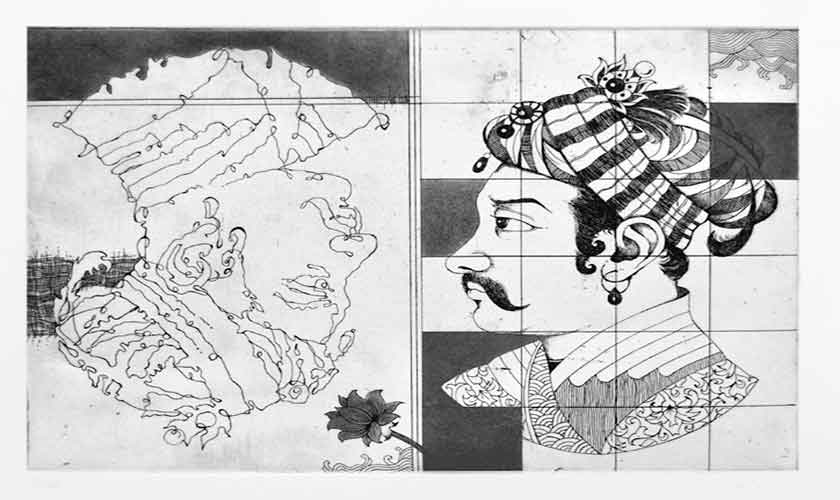irst a joke: A corporateemployee attending his boss’s funeral, and kneeling subsequent to the CEO’s picket coffin,saved speaking to himself: Now who’s considering out of the field?
The phrase, typically heard in places of work, companies and banks – even in educational surroundings, means leaving one’s customary apply, for one thing new, unexpected anddaring. This can be a fixed strain from one’s superiors and the market. Additionally it is an inner demand.
RM Naeem has actually illustrated this example in his print Pondering About …, wherein a younger boy is rising out of an open field. The delicate drawing of youth’s options, arms, his gown, together with cushion, guide, and the background seem within the line-etchingcreated for Re-examine Retrace 2.0; a printmaking undertaking conceived by Studio RM and Adeeluz Zafar. Works produced by 26 individuals are on view – from January 13 to 23 – on the ‘O’ Artwork Area, Lahore.
The undertaking/exhibition includes artists who weren’t trainedas printmakers. They have been invited to do prints in an identical measurement and uniform numbers, utilizing any methodology (for a box-print). All the thought of approaching these for whom printmaking is a distant self-discipline is to make them assume out of the field. Important, since knowledgeable typically indulges in repeated visuals, methods, codecs and themes. A survey of Pakistani artwork might disclose how sure artists after rising to a snug degree of success, discover it handy to re-produce their tried and examined items.
Artists included in Re-examine Retrace 2.0 can’t be labelled below that class, as a result of venturing right into a (comparatively) new medium grew to become the explanation for some thrilling imagery. The works of those individuals can simply be divided into two teams:one which carry the mark of the maker, and different which require deciphering the artist’s signatures on the backside of the plate for his/her id.
One may method the present by way of two factors:newness in a person’s aesthetics brought on by an uncommon method; and the novelty in an individual’s imagery – no matter what medium he/she has employed. In eithercase, there are some extraordinary outcomes; like Mohsin Shafi’s Love Simply Can’t Not Be Loopy. Utilizing stamping, embossing and Xerox printing, Shafi has created a facsimile of widespread illustrated treatises of affection in Urdu. Manuals to reach issues of the guts which might be cheaply printed and offered;recipes, directions and amulets to beat one’s belovedare reprinted by the artist in a grid of open publications (with some interventions/ overlapping by him).
Shafi’s print reminds us of the historical past of printing in our area, in addition to its class-division. His determination to breed footage of these humble booklets is a approach of paying homage to a type of artwork thatexistswithout being acutely aware of it. The exhibition includes quite a lot of works that reveal how a inventive thoughts handles one other medium and transforms it. Ayaz Jokhio’s Cotton/Cloud is an instance on this regard. Cyanotypes is a method of inserting an opaque object on a sensitised paper, and exposing it to the sunshine. This leads to fixing the picture on the sheet as clean (white) and leaving the remainder of the world cyan. Jokhio has put (bodily) items of cotton to transform them into (optical) clouds.
It’s not solely metaphors; locations of residence additionally crumble with the passage of time. Risham Syed, in her silkscreen print, recreates Decrease Mall Sequence, a visible of ancestral household home, deserted, depilated and misfit – one other metaphor for the previous. The previous is punctured for a brand new notion in Kiran Saleem’s print Reimagined Historical past. Luscious burgundy background of flowers (from some historic reference) surrounds a central oval. In Saleem’s print it disappears. There’s a void;a white patch. Saleem’s print impresses a viewer with its richness of floor and hue, whereas posing a query in regards to the hierarchy that usually manifests within the type of centrality.
Hamid Ali Hanbhi, for his display print The Custom, has assembled three girls huddled collectively in Afghan burqas,commenting on the invisibility of girls below this piece of garment. Intriguingly, the format of Hanbhi’s burqa-clad females finally ends up as a person’s profile. A totally unintended studying?An accident?
Some artists have replicated their secure and inventory imagery of their prints. Adeel-uz Zafar’s unbelievable bandaged toy determine (Mouse), Amin Gulgee’s mixture of calligraphic marks (Algorithm 7), Ghulam Mohammad’s celebrated tiny texts in Hisaar(siege) reaffirm the success of those artists’ works seen through the years. However, just a few comparatively new artists, supply unusual parts of their work. Amna Rahman, along with her exceptional facility for conveying the presence and feeling of an individual at a setting that could possibly be anyplace – and nowhere, has created a lino-cut of a feminine amid blades of grass. Resting and considering, the character in Rahman’s print signifies nervousness, obsession and repose – allat as soon as.
Rahman’s magnificent facility with thelino-cut instrument could be matched by Suleman Khilji’s development of Transit, a piece that in its format and therapy resonates with historic depictions and accounts of travellers throughout the shores. In a magical-realistic tone, the modelin Khilji’s print looks like a modern-day incarnation of Don Quixote.
The connection of state andsociety and their phantoms are seen in works coping with some persisting points. For instance, Shehzil Malik’s wonderful and socially consciousprint on feminine emancipation, with its content material/message inscribed in Urdu.
The identical matteris addressed in a relatively distant method by Sadaf Naeem with faces of girls drawn behind an internet of traces. An analogous method in the direction of feminine presence is noticed in Saulat Ajmal’s Haloed Grace, with a mysterious/invisible determine – one thing rising out of Italo Calvino’s fiction that takes over the centre house.
The author is an artwork critic based mostly in Lahore
